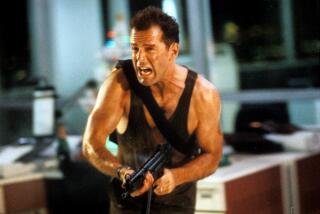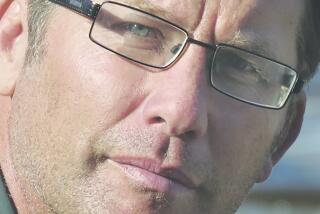A look inside Hollywood and the movies : . . . AND HE DIDN’T NEED AN AGENT : A Whale of an Actor in a Killer Part
- Share via
Aquatic theme parks take note: Once kids see “Free Willy,” they’ll want to do more than just save the whales. They’ll want to liberate them.
If the movie becomes the sleeper of the summer, as Warner Bros. hopes, expect kids to pressure mom and dad to return the world’s largest mammals in captivity to their natural habitats.
The star of “Free Willy” is about as affectionate a 7,000-pound killer whale as there is. Or at least he is to the former street urchin Jesse (Jason James Richter) who bonds with him outside his glass seaquarium tank at the dilapidated fictional Pacific North West Adventure Park. They discover each other when Jesse, now in foster care, returns to clean off the graffiti he sprayed on Willy’s habitat; both are lonely and miss their mothers.
The script caused Australian director Simon Wincer to well up in tears when he first read it two years ago. And numerous Warner Bros. research screenings for school-age children across the country in recent weeks have met with similar reaction. The high approval ratings have persuaded Warners to hold more previews in hopes of building word-of-mouth well in advance of the picture’s scheduled July 16 opening. (There are more than 60 other movies opening this summer.)
“The movie just seems to have that effect on people. It deals with foster parents and street life and animals in captivity,” Wincer said. “If you say it’s about the environment . . . that would be a turn-off. The film’s really about family.”
Despite the film’s strong, pro-animal liberation theme, Wincer never intended “Free Willy” to encourage juvenile civil disobedience. (In the movie, Willy’s greedy owners aren’t keen on Jesse’s scheme to free the whale.)
“If you think about (the animal keepers) having to face a decision whether to leave the whale in its leaking tank or put him back in the ocean . . . well, I suppose it’s breaking the law in a little way,” he said. “But Americans love to see people do something that’s morally right if not necessarily legally right; the underdog winning. Don’t they?”
Yes, they do.
Wincer directed the acclaimed “Phar Lap,” about Australia’s most famous race horse, and was executive producer of the Australian hit “The Man From Snowy River” but is not principally thought of in this country for those animal-friendly movies.
Rather, Wincer’s name has become nearly synonymous with the miniseries “Lonesome Dove” that he directed to great critical and commercial acclaim. (There were animals in the multi-Emmy-winning telefilm: A couple of pigs provided endless comic relief for Robert Duvall’s wry character Gus McCrae.)
Yet, he’s ever-mindful of the earth’s fragility and returns to the topic often.
Prior to signing on to direct this $20-million production last spring (and only five weeks before shooting began), the director spent the two previous years jumping continents while directing episodes of television’s “Young Indiana Jones Chronicles.”
His assessment: The Soviets trashed Czechoslovakia, Istanbul has filthier air than Los Angeles and the refuse from Japanese trawlers somehow ends up along the banks of Kenya’s rivers.
“A lot of the world’s in a terrifying mess. Sad, isn’t it?” he asks, shaking his head.
Wincer returns to the problems associated with shooting “Free Willy,” which he described as a logistical “nightmare.” The cast and crew moved from Mexico City northward to the Warner Ranch in Southern California, various Oregon sites that included Portland and Astoria, Washington’s San Juan Islands and, of course, out over the Pacific Ocean to capture aerial footage of migrating whale pods.
At least when he joined the production, having been brought in at the last minute to replace a director who the producers decided was too inexperienced, the key casting of Willy was already in place.
The filmmakers had secured the loan of Keiko, a 12-year-old trained Orca from Mexico City’s Reino Aventura theme park, which coincidentally was undergoing a renovation and could afford to loan the mammal out. Also camera-ready was Keiko’s double, a free-swimming, four-ton, 22-foot animatronic whale designed by Walt Conti that was used in all the underwater ocean scenes and in scenes when Jesse finally gets up the nerve to ride him around the whale pool.
Casting for the role of Jesse was next and highly critical, since both boy and whale are in nearly every scene together. Richter’s combination of athleticism mixed with “a slight devilish streak” won him the part over 11 other child actors.
Keiko took direction better than some actors, the director said, without a hint of sarcasm in his voice.
“He was a great performer. You’d tell him where to go and he’d go right there . . . the closest thing to a human animal I have ever worked with,” Wincer said, recalling Keiko’s habit of plopping his massive head on the side of his tank to watch the carpenters build the set and later the cameramen as they set up shots.
Mirroring his behavior in some of the more poignant scenes in the movie, Keiko sensed that he was being abandoned on the last night of filming “Free Willy,” pacing around his pool doing tricks to attract attention.
The fate of “Free Willy” won’t be determined until the picture opens, and the fate of the whale actor who plays him is similarly undecided. Keiko, like Willy, is still growing and soon will be too big for his habitat in Mexico City.
Where do the filmmakers, who’ve set up a foundation to find Keiko a new home, hope to place him?
“A sea park where they’ve been breeding whales in captivity and there are pools large enough for mothers to suckle their young,” said Wincer.
More to Read
The biggest entertainment stories
Get our big stories about Hollywood, film, television, music, arts, culture and more right in your inbox as soon as they publish.
You may occasionally receive promotional content from the Los Angeles Times.










